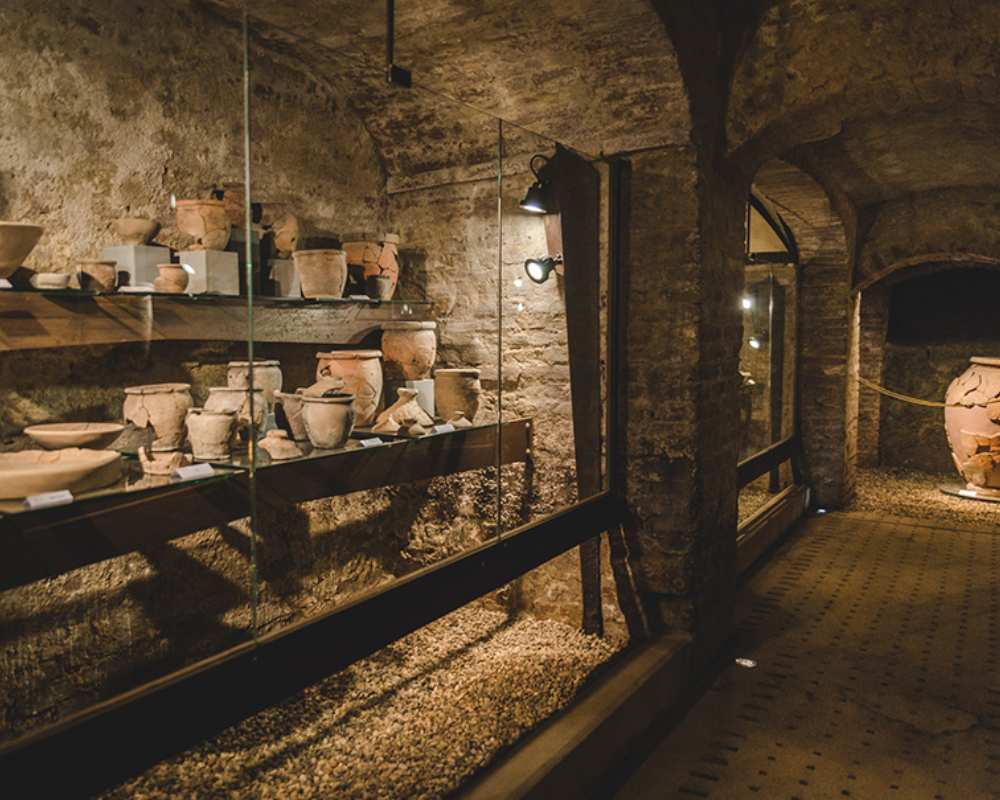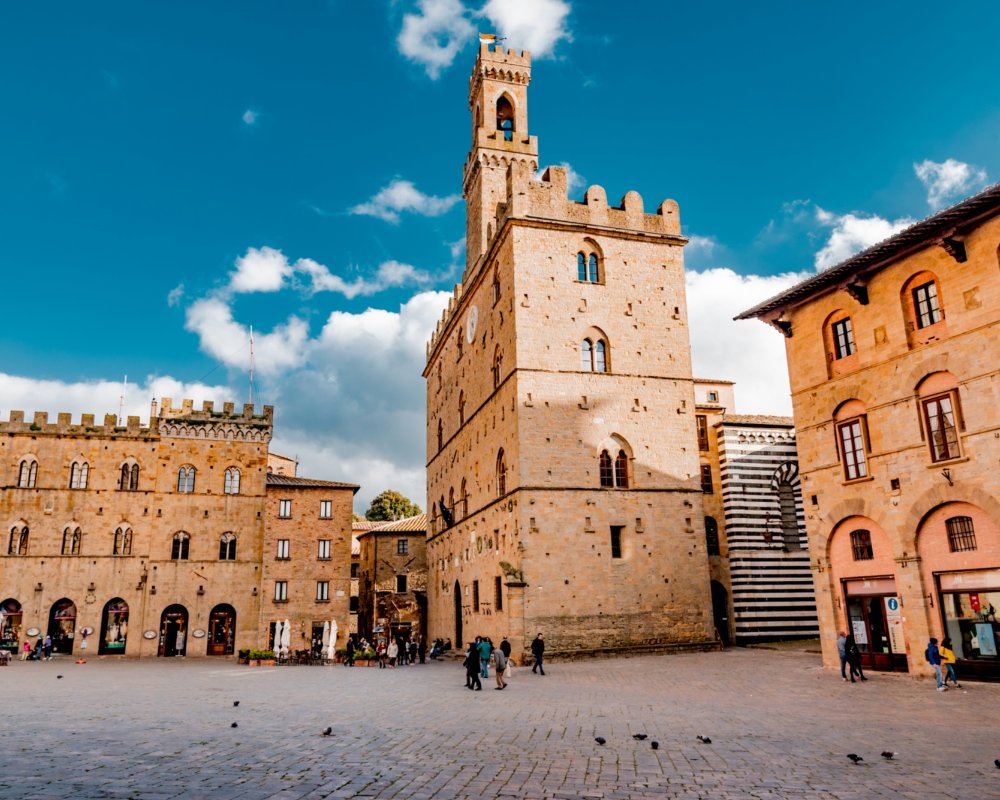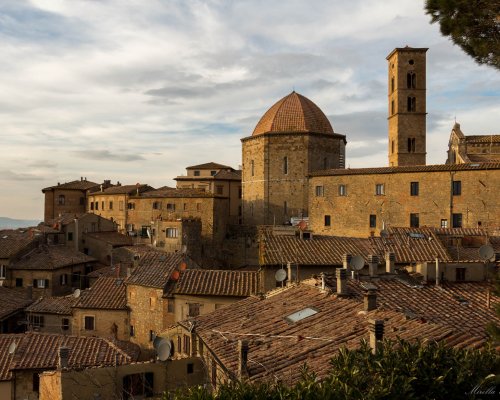An itinerary to explore the history and landscape of the Valdelsa and Valdicecina
This itinerary explores the area that was historically linked to the ancient via Cassia, the Roman road that likely followed the even older Etruscan way, touching some of the smaller towns in the area around Volterra. Once upon a time, the road was a communication route between these towns and another large city, Chiusi.
A road also deviated off to the north, towards Fiesole and Artimino. There haven’t been many discoveries related to these small towns, but what has been found is nonetheless important, especially in the Valdelsa (Monteriggioni, Castellina in Chianti, San Gimignano) and the Valdera (Villamagna, Lajatico).
The itinerary begins in Pisa. Crossing through the hills of the Valdera, it arrives in Volterra (known as Velathri by the Etruscans).
The city has ancient origins dating to the Copper Age: traces of the Villanovans were even discovered, but it was during the Etruscan era that small towns began to form in the area. Volterra has never been abandoned, continuing to be inhabited through the Roman era, Middle Ages and even today.
The itinerary winds through the Porta all’Arco, or Arco Etrusco, which was once part of the 4th-century BCE walls. The gate is decorated with protomes in the shape of heads that probably represent the goddesses who protected the entrance to the city. We continue down Via di Porta all’Arco in the direction of Piazza dei Priori, with the Palace of the same name, the oldest town hall in Tuscany, the Cathedral and the Guarnacci Museum, home to one of the most important Etruscan collections in Italy.
The itinerary begins in Pisa. Crossing through the hills of the Valdera, it arrives in Volterra (known as Velathri by the Etruscans).
The city has ancient origins dating to the Copper Age: traces of the Villanovans were even discovered, but it was during the Etruscan era that small towns began to form in the area. Volterra has never been abandoned, continuing to be inhabited through the Roman era, Middle Ages and even today.
The itinerary winds through the Porta all’Arco, or Arco Etrusco, which was once part of the 4th-century BCE walls. The gate is decorated with protomes in the shape of heads that probably represent the goddesses who protected the entrance to the city. We continue down Via di Porta all’Arco in the direction of Piazza dei Priori, with the Palace of the same name, the oldest town hall in Tuscany, the Cathedral and the Guarnacci Museum, home to one of the most important Etruscan collections in Italy.
Leaving the museum behind, the road head down along Via Don Minzoni (a road dating to the Etruscan era), coming to Porta a Selci and continuing down Via di Castello, flanking the fortress, to reach the Etruscan-Roman Acropolis. The archeological site is located inside the large “Enrico Fiumi” Park: inn addition to the Etruscan walls that border it, thre are also some cisterns, two temples and the ruins of a flagstone street connected to the city’s sacred area.
Leaving the park, going down through Via Matteotti - Via Guarnacci and passing through Porta Fiorentina, we arrive in the Vallebuona Archeological Area. Here we can see a theatre, with its cavea comprised of 19 rows of seats. Further on, there are ruins of baths dating to the 4th century CE.
Before leaving Volterra, one cannot fail to visit the area of the Balze, sand cliffs settled atop a clayey base, shaped by collapses and erosions, which have given life to a unique and fascinating landscape.
Leaving the museum behind, the road head down along Via Don Minzoni (a road dating to the Etruscan era), coming to Porta a Selci and continuing down Via di Castello, flanking the fortress, to reach the Etruscan-Roman Acropolis. The archeological site is located inside the large “Enrico Fiumi” Park: inn addition to the Etruscan walls that border it, thre are also some cisterns, two temples and the ruins of a flagstone street connected to the city’s sacred area.
Leaving the park, going down through Via Matteotti - Via Guarnacci and passing through Porta Fiorentina, we arrive in the Vallebuona Archeological Area. Here we can see a theatre, with its cavea comprised of 19 rows of seats. Further on, there are ruins of baths dating to the 4th century CE.
Before leaving Volterra, one cannot fail to visit the area of the Balze, sand cliffs settled atop a clayey base, shaped by collapses and erosions, which have given life to a unique and fascinating landscape.
Leaving Volterra, our itinerary continues on to San Gimignano, the tonw that dominated the Valdelsa. San Gimignano has Etruscan origins, but its height of development came in the Middle Ages, at the time it was crossed by an offshoot of the Francigena and dotted with more than 70 towers (13 of which still remain today), testaments to the conflict between the Guelphs and Ghibellines.
To enjoy a view of the countryside, we recommend climbing the Poggio della Torre or the Montestaffoli fortress. At Porta delle Fonti (underneath Poggio della Torre) there are fountains dating to the 12th-14th centuries, covered by Gothic arches.
Leaving Volterra, our itinerary continues on to San Gimignano, the tonw that dominated the Valdelsa. San Gimignano has Etruscan origins, but its height of development came in the Middle Ages, at the time it was crossed by an offshoot of the Francigena and dotted with more than 70 towers (13 of which still remain today), testaments to the conflict between the Guelphs and Ghibellines.
To enjoy a view of the countryside, we recommend climbing the Poggio della Torre or the Montestaffoli fortress. At Porta delle Fonti (underneath Poggio della Torre) there are fountains dating to the 12th-14th centuries, covered by Gothic arches.
From San Gimignano, let’s continue to Certaldo, a town of Etruscan origin which takes its name from the Latin “cerretum altus”, a reference to the the oak woods that characterize the hill.
Certaldo is also where Giovanni Boccaccio was born and died; his childhood home is now a museum.
We suggest visiting the upper part of the city, where Palazzo Pretorio is located, whose fortified tower is the only part remaining of the Alberti castle (12th century); the other parts date to the 1400s.
From San Gimignano, let’s continue to Certaldo, a town of Etruscan origin which takes its name from the Latin “cerretum altus”, a reference to the the oak woods that characterize the hill.
Certaldo is also where Giovanni Boccaccio was born and died; his childhood home is now a museum.
We suggest visiting the upper part of the city, where Palazzo Pretorio is located, whose fortified tower is the only part remaining of the Alberti castle (12th century); the other parts date to the 1400s.
What to see in the area

If you’re looking to modify this itinerary a bit, staying on the subject, head to the Archeological Museum in Peccioli, the Archaeological Documentation Exhibition Centre in Capannoli, the Etruscan necropolis in Terricciola and the Civic Museum in Montaione.


